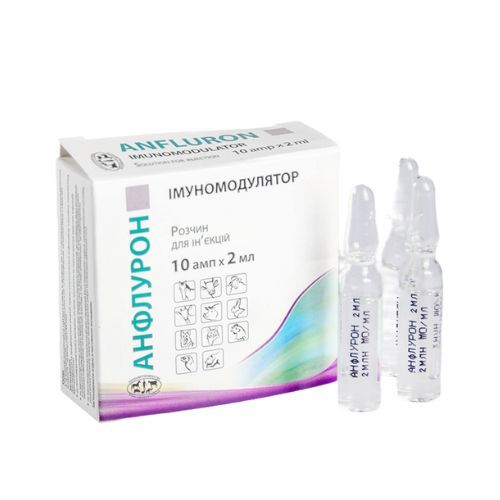|
Quantity
|
Out of stock
|
||
|
|
|||
Anfluron 2 MO, 2 ml The drug requires mandatory temperature control during transportation. Buy a thermobox! Composition Sterile isotonic (0.15 M NaCl, 0.1 M Na-, K-phosphates pH 7.2-7.4) aqueous solution of recombinant a- and g-interferons - analogues of human a-2a- and g-interferons, total protein < 15 μg / ml. Pharmacological properties Interferons (IFN) are a group of biologically active proteins or glycoproteins synthesized by cells during a protective reaction to foreign agents - viral infection, antigenic or mitogenic effects. IFN from different species of animals, despite minor interspecies differences in amino acid composition, work effectively in the organisms of heterogeneous animals. When IFN comes into contact with various cells of the body, the latter become immune to almost all known viruses and many toxins of protein and other nature. IFNs, unlike immunostimulants (IFN inducers), are powerful modulators of the immune system. a-IFN is produced by lymphoid cells in response to foreign agents - viruses, bacteria or neoplastic agents. Activates almost all cells of the immune system, promotes the production of antibodies. Modulates B-cell immunity. g-IFN is produced by activated T-lymphocytes. Activates cells of the immune system, especially macrophages (increases activity by 1000 times). Modulates T-cell immunity. Antiviral activity is lower than that of a-IFN. Application The drug is intended for the treatment and prevention of agricultural, domestic animals and poultry in diseases of various etiologies (infectious, invasive, oncological, immunodeficiency): - as an antiviral agent for acute, chronic and persistent viral infections; - as a general immunomodulator for activation of cellular and humoral immunity in many pathologies, including immunodeficiency and immunosuppressive conditions caused by an infectious or invasive agent, antibiotic and chemotherapy. - as a local immunomodulator to create locus resistentio majoris (joint diseases, wounds of various etiologies, local diseases of the skin and mucous membranes, etc.). Dosage For viral infections The initial course of anfluron is administered intramuscularly for 1-3 days until the therapeutic effect is achieved. Adult animals (1 year and older) Shock doses: - small and large breed dogs - 1-2 ml per head, respectively; - cats, rabbits, minks, nutria 0.5-1 ml per head; - pigs, goats, sheep - depending on weight - 1-2 ml per head; - cattle, horses - depending on weight - 2-3 ml per head. When continuing treatment in cases of chronic persistent viral infections, switch to maintenance doses (1/2 of the loading dose), a course of 7-10 days, maximum 30 days. Young animals (up to 1 year) - 1/2 of the adult (loading and maintenance) doses, respectively. In immunosuppressive conditions caused by intoxication due to long-term antibiotic and / or chemotherapy, against the background of current treatment - maintenance doses, a course of up to 10 days, subsequent treatment - 1/2 of the maintenance doses. In malignant diseases of organs and systems Three loading doses of anfluron, a course of 14-28 days with mandatory symptomatic therapy and monitoring of laboratory parameters (blood, urine, etc.). If it is possible to introduce directly into the tumor, as a rule, no more than 0.5 ml per 1 kg of animal weight at a time. A combination with chemotherapy and radiotherapy is possible. Effective in postoperative treatment as a cytostatic. In parasitic diseases Intracellular invasions, including chlamydia - shock doses for the first 3 days, maintained for 7-10 days. Combinations with antibiotic and chemotherapy are possible. Other invasions - for immunocorrection, maintenance doses for 10 days in combination with chemotherapy. In diseases of the immune system (chronic immunosuppression): - for courses of no more than 1 month, maintenance doses are maintained every other day; - for courses* longer than 1 month - maintenance doses every other day for 14 days, then switch to 1/2 of the maintenance doses every other day under the mandatory control of immunological and hematological parameters. In eye diseases Viral, post-traumatic (including postoperative) keratitis, conjunctivitis, etc. 2-3 drops in the eye 3-4 times a day. In more severe cases, retrobulbar blockade with anfluron is possible (single shock dose or multiple maintenance doses). Skin diseases Post-traumatic, post-operative wounds - Anfluron 1:10 in sterile saline solution in the form of applications to wounds and/or aspiration into the wound cavity through drainage in combination with antibiotic or chemotherapy. The solution of the drug is prepared before use and stored for no more than 24 hours at a temperature of (4-8) ° C. The dosage of Anfluron should not exceed 1.5 loading doses per day for a course of up to 5 days and 0.75 loading doses for a course of treatment longer than 5 days. For trichophytosis - a loading dose of Anfluron intramuscularly in combination with a vaccine. The Anfluron solution is prepared before
































